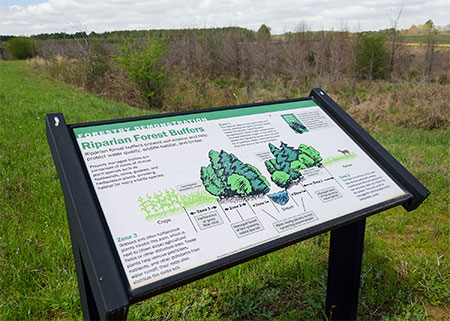News
The information presented on this page may be outdated. It may refer to situations which have changed or people who are no longer affiliated with the university. It is archived as part of Mississippi State University's history.
MSU research facility changes to meet needs

Mississippi State University's Coastal Plain Branch Experiment Station is completing a transformation from the state's premier dairy research facility to a site that focuses on land management. (Photo By: Kevin Hudson)
9/17/2015
By: Susan M. Collins-Smith
"When dairies began to close in the early 2000s as a result of the economic landscape, we took a look at what clients in the area could benefit from," said Adam Rohnke, a wildlife biologist with the MSU Extension Service. "We knew the best option would be to provide research and hands-on learning opportunities aimed at land management with an emphasis on natural resources and conservation."
The 1,172-acre station in Newton County now supports an integrated research and education program directed at adults, children and natural-resource professionals. It includes five demonstration areas: agriculture, forestry, wildlife management, backyard habitat, and a nature trail and pond. A small beef-cattle herd replaced the dairy herd, and soybeans fields are part of the station's agricultural research.
"Our goal is to provide landowners with tangible examples of how to optimize all of the natural-resource assets on their property sustainably and, at the same time, provide educational opportunities for the general public and professionals," said Rohnke, who served on the team that helped direct the station's new vision. "When we began the redesign, we asked ourselves, 'How can we turn every element of this station into a learning opportunity for both children and adults?'"
Development of new infrastructure at the station is completed as funding becomes available. A strong network of federal, state and local natural-resource agency partners provides funding, technical assistance and in-kind contributions toward the station's continuing development.
Three of the five demonstration areas have been completed, including the backyard habitat, the nature trail and lake, and an 80-acre mixed pine and hardwood timber stand. Educational signs in each area explain how to manage farm ponds, design nature trails and install a wildlife-friendly landscape. The areas also serve as outdoor classrooms for youth activities.
Since 2008, Extension and Mississippi Agricultural and Forestry Experiment Station personnel, with cooperation from allied organizations, have provided educational programs at the station for 750 students and hundreds of landowners and professionals. This year, the station hosted a prescribed-burn workshop for landowners. Staff members are preparing for an upcoming seminar on warm-season grasses for MSU Extension Service employees. For the first time, the station was selected to host the 2015 Mississippi Forage and Grassland Council annual conference, which will be on Nov. 6.
The forestry demonstration area focuses on research specifically for loblolly pine varietal performance and the potential for growing switchgrass within traditional pine stands. Other forestry research at the station includes a hardwood mixing study that examines the performance of cherry bark oak, willow oak and swamp chestnut oak when mixed with river birch, sweetgum and eastern cottonwood. Randy Rousseau, an Extension and research professor in the MSU College of Forest Resources, directs these projects.
When Brett Rushing joined the team in 2014, the station's agricultural research continued to expand. Rushing studies the use of native grasses for forage, conservation and biomass crop production.
"My research concentrates on sustainable production and use of forages for livestock producers," said Rushing, an Extension and research professor. "This involves managing soil fertility, increasing forage utilization and diversifying forages in a producer's grazing system, ultimately improving soil health, reducing feeding costs and improving wildlife habitat."
Native, warm-season grasses are ideal for the Southeast. They are drought tolerant and provide an excellent source of summer forage for cattle and suitable cover for grassland birds and small mammals. However, most commercially available varieties originate from the Midwest and Northeast. Rushing said he believes native varieties developed in the Southeast will perform much better than the varieties on the market now.
"Commercially available native, warm-season grass varieties are still relatively wild, and they don't germinate well," Rushing said. "Our field trials prove that the native grasses bred with enhanced establishment qualities outperform traditional varieties, which will enable them to be released and licensed for sale."
In a separate study, Rushing is measuring livestock and forage production by comparing performance of several native, warm-season grasses with bahiagrass, which is grown by about 30 percent of central and south Mississippi cattlemen.
"Bahiagrass is easy to establish and is tolerant to a somewhat low soil pH, but it provides no grassland habitat for wildlife and produces moderate weight gains for grazing cattle," he said. "This study could help us recommend a better forage for cattle producers that can also protect the wildlife on and near their property."
Several other forage-related trials have been established at the station, including a fertility management study with native grasses, a potassium management study with alfalfa and two studies evaluating Southeastern wildrye as a potential forage crop for Mississippi.
Rushing is also working with canola, a potential biofuel crop that could be used to make biodiesel. Rushing participates in a national canola variety trial, which could prove that canola is a valuable crop for Mississippi farmers.
"There is a slight interest in the use of canola as an alternative crop that could produce biodiesel in the Deep South," Rushing said. "Canola would be a potential cool-season rotational crop like wheat. Our trial is located the farthest south. If the trials do well, we could use our data to leverage future funding to investigate production and management strategies for the Southeast."
View More News